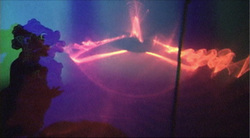 This microtonal music thing Kraig Grady does -- people are puzzled by it, assume it’s weird. Hearing his homebuilt xylophones and organs dingdong and drone, though, you realize how natural it is. And Grady is really a traditionalist. The traditions he follows just aren’t mainstream America’s.
This microtonal music thing Kraig Grady does -- people are puzzled by it, assume it’s weird. Hearing his homebuilt xylophones and organs dingdong and drone, though, you realize how natural it is. And Grady is really a traditionalist. The traditions he follows just aren’t mainstream America’s.
Altadena’s Folly Bowl is the ideal setting for Grady’s art, which in this instance included one of the shadow plays (puppets and lights behind a screen) that he presents semiregularly. In what’s essentially a private home’s small backyard garden amphitheater, a near capacity audience of maybe 80 people, ages 30 to 60 plus a few children, sat on stairs and in terrace niches, breathing in the cool night’s arboreal odors, listening to the crickets that complemented the more organized sounds rising from below. It was all very civilized, in a way the counterculture of yesterday idealized and the counterculture of today still pines for. We are aesthetes; when the revolution comes we’ll be slaughtered like sheep.
There’s some tension between Grady’s music and the dramatic framework of his shadow plays -- this one had a loose theme of cloning. On the one hand, the sounds generate maximum effect when the rhythms are slowest and the vibrations have room to fill the space, overlap and interact; the physical frissons generated by unfamiliar combinations of notes are microtonal music’s most involving expressions. And this night provided quite a few of these moments: static chills, transient harmonies, and especially the deep throb welling from a large piece of metal, which made you feel you were being hugged to the chest of some huge furry beast. On the other hand, the narrative demanded music for marching, battling, arguing -- activities that don’t leave much space. The lack of drums and strong rhythms made the aural experience more diffuse.
The visuals had their own appeal, though. The puppets’ lacy textures were lovely, and their movements, which included limbs moved by sticks, were sometimes graceful. One great feature of these puppets was that their stiffness could lend an interesting ambiguity to their interactions: Were they fighting or screwing? Here as in real life, the distinction wasn’t always substantial. Fuzzy background figures of a ziggurat or a mountain range lent dimension. But the best images were the most abstract: a latticed globe was spun for a kaleidoscopic effect; sheets of light danced like the aurora borealis; laser streaks zipped across the screen. Sight or sound usually drew you in separately rather than together.
Grady’s puppets and sounds are inspired in part by ancient Indonesian theater and by gamelan, whose instruments may have already existed when Hinduism and Buddhism arrived. In connecting to human roots, most traditionalists ring hollow because they don’t reach back far enough. But when Grady hits the right chord, he shows the value of going back, way back, as far as the mind can stretch, to something that’s been lost. What? Hard to say; it no longer has a name. You just feel it.
